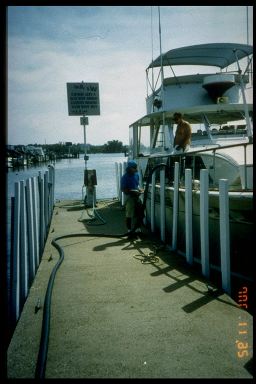
15. Kean's Detroit Yacht Harbor
Urban Marina Has Pumpout/Fuel Sales Synergy
| Location: | 100 Meadowbrook Ave., P.O. Box 14189, Detroit, Michigan 48189-0189 |
| Telephone: | (313) 822-4500, fax: (313) 822-5442 |
| Interviewed: | John Kean, CMM, Owner and General Manager |
| Waterbody: | Detroit River, below Lake St. Clair, facing Canada |
Environmental change
Four full-serve pumpout stations, which can service every boat tied in eight fuel docks, attract new customers who also buy fuel.
The urban marina
Kean's Detroit Yacht Harbor is a private commercial, seasonal business that is considered a home port for its customers, although it is also a popular stopoff for transient boaters. Within a 2-mile radius nearly 1,000 boats are kept in eight other marinas and yacht clubs.
Kean's and the subleased boat services have a combined payroll of 40 full-time employees year-round plus 10 part-time in the boating season. The business has a summer season storage capacity of 330 boats in slips and 50 on land; its winter indoor and outdoor land storage is 525 boats. Boat sizes range from 22 to 46 feet with the average at 31 feet. Other services and profit centers include transient dockage, launch/haulout, used boat brokerage, retail store, bait/tackle sales, food/beverage/ice sales, and laundry. A significant retail market for Kean's is Canadians who cross the river to buy alcohol, cigarettes, and gasoline at lower prices; many also get pumped out. On a busy summer weekend about 15% of the boats would be used, half of which would have people sleeping aboard overnight.
The full-service marina was first built in 1931 by Marvin Kean and was bought by his son, John, in 1980. Winter inside and outside boat storage and boat repairs have always been an important part of the business. Boats are hauled by an Algonac sling lift on rails and moved with a hydraulic trailer, forklift, and crane. Trained technicians repair paint, fiberglass, engines, canvas, and hulls.
Management measures
Kean's Detroit Yacht Harbor complies with the marina management measures for sewage facility and maintenance of sewage facilities, as well as shoreline stabilization, storm water runoff control, fueling station design, solid waste, liquid materials, petroleum control, and public education.
Costs/benefits
Kean's Detroit Yacht Harbor, for a capital cost of $12,000 in 1990 and an annual operational/maintenance cost of $1,040, last year grossed $3,000 in pumpout income plus an additional $8,000 in fuel sales, as a result of providing convenient, one-stop, staff-operated (full-service) pumpout service at the boat fueling station, bringing a gross $8,400 income to the business this year.
Environmental improvements
Because the marina is located on a no-discharge waterway, owner John Kean feels that providing pumpout service is an essential responsibility of his marina and other large marinas. At the Detroit Yacht Harbor, pumpout service was first made available in 1975 with a pumpout cart that was pulled to boats in slips. The cart was then emptied into a connector to the city's wastewater treatment system. But the mobile service was labor-intensive, slow, and not as well used by boaters as expected.
To make the sewage pumpout service more efficient, convenient, and cost-effective, Kean installed a fixed system at his fuel docks in 1990. A commercial 200-gallon vacuum tank, located on the inland side of his office/retail building, pulls sewage through 120 feet of underground 2-inch vacuum lines from four dockside fuel stations, each with on/off switches, to the vacuum tank. When the tank nears full, the vacuum tank automatically cycles from vacuum to a pressurized tank, which blows the effluent into the marina's outgoing sewer line to the city's system. Once empty, it automatically reverses its valves and again builds a vacuum. Indicator lights on each dockside pumpout post indicate whether the system is on vacuum and available for use, or on pressure and emptying.
 |
In 1994, the marina provided over 1,200 pumpouts, charging $5 per pumpout to Kean's seasonal slip customers and $10 to outside boaters. "As part of our marina marketing package, we offer discounts to our slip customers of 50% per pumpout and 15% off gasoline sales," said John Kean, "and we are 95% occupied for the 1995 summer season. The pumpout income is almost 100% profit, and the extra fuel sales net about $0.30 per gallon sold."
"One key to our success," said Kean, "is having our fuel dock staff do each pump-out. Despite having six other do-it-yourself pumpout stations within 2 miles of our docks, we attract boaters to our service be-cause it is an easy and quick pumpout. Customers only want to dock their boat once. That's why we put the pumpout on the fuel dock. The pumpout only takes 15 to 30 seconds to empty the holding tank, and (contrary to what some marina managers fear) does not slow our boat-fueling operation."
"But I do not believe that our pumpout service has improved water quality,"
lamented Kean. "We are one-third mile downstream from Detroit's sewer plant
outfall. When it rains, the city's combined storm water and sewage system dumps raw
sewage into the river. However, I do believe that we have a synergistic fuel/pumpout
business advantage which complies with Michigan's strictly enforced no-discharge
law and ban on Y-valve use."
As part of John Kean's ongoing process of strengthening his marina business, he has made many other environmental improvements in recent years. Remodeled and improved restrooms are well used and appreciated by customers. Along with the pumpout service, the gasoline-only fueling operation has been upgraded and has spill control gear at the ready. Boats kept in the marina now use oil absorption pads in bilges. Oil, cans, bottles, and batteries are recycled. Kean's earns $5 for each battery turned in. Clean boating educational efforts include articles in three newsletters per year, new signs, and contract language. Dog owners have a designated grassy area to walk their pets. Only dustless sanders can be used in the marina. Grass and planter beds buffer the river from parking area runoff.
Well-placed and well-maintained grass, flowers, shrubs, and trees make this facility seem less urban. A nicely decked swimming pool, jacuzzi, and changing rooms also make Kean's a popular oasis in an otherwise unattractive section of Detroit.
Equipment source
- Vacuum pumpout unit: Tank Truck Services, 25150 Dequindre, Warren, MI 48091.
http://www.epa.gov/owow/NPS/marinas/ch15.html
This page last updated October 4, 1999


